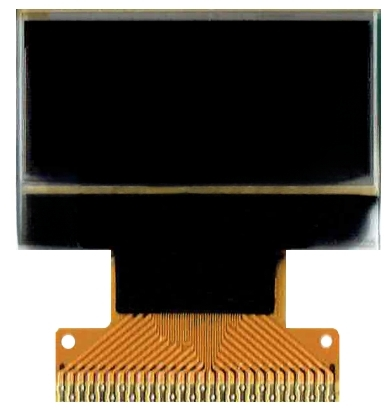+44 (0)1634 791600
info@crystal-display.com
Newsletter Sign Up!
+44 (0)1634 791600
info@crystal-display.com





In the ever-evolving landscape of display technologies, one innovation that has been quietly making waves is PMOLED (Passive Matrix Organic Light-Emitting Diode) displays. These mesmerizing displays combine the brilliance of OLED technology with a simplified matrix design, offering a unique and versatile visual experience. In this blog post, we’ll delve into the world of PMOLED displays, exploring their key features, applications, and the enchanting possibilities they bring to the forefront of display technology.
PMOLED displays are a subset of OLED displays, renowned for their organic compounds that emit light when an electric current is applied. What sets PMOLED apart is its passive matrix structure, where each pixel is controlled individually. This design simplicity contributes to the cost-effectiveness and efficiency of PMOLED displays.


A PMOLED (Passive Matrix Organic Light-Emitting Diode) display is a type of display technology that falls under the broader category of OLED (Organic Light-Emitting Diode) displays. PMOLEDs are known for their unique structure and characteristics, making them suitable for various applications ranging from wearable devices to automotive displays.
Vivid Colors and High Contrast: PMOLED displays offer vibrant and saturated colors with a high contrast ratio, providing a visually stunning experience. The organic compounds emit light directly, resulting in deep blacks and vivid colors that captivate the viewer.
Flexibility and Thin Form Factor: The organic materials used in PMOLED displays are inherently flexible, allowing for the creation of curved and bendable screens. This flexibility, coupled with their thin form factor, opens up new possibilities for innovative designs in various electronic devices.
Fast Response Time: PMOLED displays boast a fast response time, ensuring smooth motion and reduced motion blur. This feature is particularly advantageous in applications where quick transitions and responsiveness are critical, such as gaming or virtual reality.
Energy Efficiency: Since each pixel in a PMOLED display is controlled individually, only the active pixels emit light. This results in improved energy efficiency compared to traditional displays, making PMOLEDs ideal for portable devices where battery life is a primary concern.
Wearable Technology: The thin and flexible nature of PMOLED displays makes them ideal for wearable devices such as smartwatches and fitness trackers. Their ability to conform to curved surfaces ensures a comfortable and visually appealing user experience.
Automotive Displays: PMOLED displays find applications in the automotive industry, providing vibrant and high-contrast screens for dashboard displays, navigation systems, and entertainment consoles.
Consumer Electronics: From smartphones to digital cameras, PMOLED displays are making their mark in various consumer electronics, enhancing the visual experience with brilliant colors and sharp contrasts.
Industrial and Medical Devices: The fast response time and vivid display of PMOLEDs make them suitable for applications in industrial control panels, medical equipment, and other devices where clarity and responsiveness are essential.
OLED technology outperforms traditional LCDs in small graphic displays. Many applications are shifting from monochrome LCD and TFT LCD to OLEDs for their superior visibility, fast response times, and low power consumption. OLEDs come in various sizes, offer full RGB colour, monochrome options, and character displays in different colours, with compatibility for multiple interfaces.


